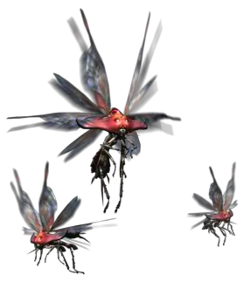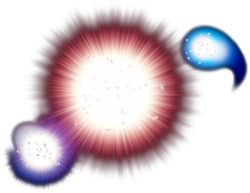Post by Bluthardt on Jun 1, 2010 1:14:35 GMT -5
Vespoid

Vespoids are known to be a nuisance for hunters, due to their stingers that flinch hunters, causing them to be exposed to any other attacks. Their stingers are loaded with neuro-toxin that paralyzes foes. They are normally placed near rocky-walls and caves and found almost everywhere. Controlled by Queen Vespoid, they are found alone in some places but appear in large numbers when with their leader.
Hornetaur

The Hornetaur are small, beetle-like insectoids found in all Monster Hunter games. Like the Vespoid, they are highly susceptible to poison. Due to their small size, they are very hard to hit directly. Hornetaurs will frequently attack the hunter in groups, making it very tedious to fight other monsters in the area. If hit with normal weapons, these monsters will frequently shatter completely.
Typically, using a poison-attribute weapon or Poison Coating with a Bow is the only way to kill and carve the Hornetaur without having them explode and be uncarvable. Poison Smoke Bombs are also useful in getting multiple Hornetaurs poisoned all at once.
Bnahabra

The new Neopteron insect-like monsters found in Monster Hunter 3 (tri). They are the MH3 equivalent of the Vespoid from previous series. They fly in a similar fashion and can also cause paralysis with its stinger. But unlike the Vespoids, they can shoot a corrosive liquid which will reduce a hunter's elemental resistance to Fire, Water, or Thunder depending on the region. There are various subspecies of the Bnahabra which, again, vary between the regions. Each has a distinct colored wing. Bnahabra are often seen attached to the sides of the walls seemingly lifeless; until a hunter is close enough and then fly away or attack.
Altaroth

Altaroths are an ant-like Neopteron featured in Monster Hunter 3. In all outward appearances, they resemble nothing more than giant ants. They live mostly in tall, narrow columns found in the Desert and are a favorite food of Barroth. They are also found in a wide range of other habitats. They can shoot a green liquid from their abdomens, which will inflict a temporary defense drop. Like other Neopterons, they shatter into pieces when killed and must be poisoned for its body to be carved.
An interesting note about the Altaroth is that they can absorb mushrooms, berries, and other map resources into the sac on their back. When you kill an Altaroth in this state, they will drop items depending on what they have absorbed. This can be taken to an advantage;if the hunter were to intercept and collect before the Altaroth reach their target, the Altaroth can be indirectly forced to consume one type of plant or mushroom. The swelling of their sacs is indicated by different colors.
Altaroths will not attack on their own unless they are threatened. The larger ones however, will attack as soon as they spot you and order the rest of the swarm to attack as well.
Great Thunderbug

The Great Thunderbugs are small wisping globes of light which seem to be swarming Thunderbugs. They are about the size of a Vespoid and have a tendency to wisp around the area rather than attack trespassers.
They are also known to change into two different colors: blue and reddish-white. When in its normal and docile state, they are blue, but when attempting to attack, the blue hue becomes a fierce, glowing reddish-white, at which time they will harm hunters with strong electrical currents.
They are naturally found in the Tower and Jungle. Eyewitness reports also claim that some elder dragons are hosts to them, providing a safe environment in which to mature. A famous example of this is the Yama Tsukami. However Thunderbugs from the Yama Tsukami are different, in that they can explode.
When slain, there's a small chance that a Thunderbug or Thunderbug Juice will be dropped. They cannot be poisoned to death in the same way as Vespoids or Hornetaurs to ensure a higher drop rate.

Vespoids are known to be a nuisance for hunters, due to their stingers that flinch hunters, causing them to be exposed to any other attacks. Their stingers are loaded with neuro-toxin that paralyzes foes. They are normally placed near rocky-walls and caves and found almost everywhere. Controlled by Queen Vespoid, they are found alone in some places but appear in large numbers when with their leader.
Hornetaur

The Hornetaur are small, beetle-like insectoids found in all Monster Hunter games. Like the Vespoid, they are highly susceptible to poison. Due to their small size, they are very hard to hit directly. Hornetaurs will frequently attack the hunter in groups, making it very tedious to fight other monsters in the area. If hit with normal weapons, these monsters will frequently shatter completely.
Typically, using a poison-attribute weapon or Poison Coating with a Bow is the only way to kill and carve the Hornetaur without having them explode and be uncarvable. Poison Smoke Bombs are also useful in getting multiple Hornetaurs poisoned all at once.
Bnahabra

The new Neopteron insect-like monsters found in Monster Hunter 3 (tri). They are the MH3 equivalent of the Vespoid from previous series. They fly in a similar fashion and can also cause paralysis with its stinger. But unlike the Vespoids, they can shoot a corrosive liquid which will reduce a hunter's elemental resistance to Fire, Water, or Thunder depending on the region. There are various subspecies of the Bnahabra which, again, vary between the regions. Each has a distinct colored wing. Bnahabra are often seen attached to the sides of the walls seemingly lifeless; until a hunter is close enough and then fly away or attack.
Altaroth

Altaroths are an ant-like Neopteron featured in Monster Hunter 3. In all outward appearances, they resemble nothing more than giant ants. They live mostly in tall, narrow columns found in the Desert and are a favorite food of Barroth. They are also found in a wide range of other habitats. They can shoot a green liquid from their abdomens, which will inflict a temporary defense drop. Like other Neopterons, they shatter into pieces when killed and must be poisoned for its body to be carved.
An interesting note about the Altaroth is that they can absorb mushrooms, berries, and other map resources into the sac on their back. When you kill an Altaroth in this state, they will drop items depending on what they have absorbed. This can be taken to an advantage;if the hunter were to intercept and collect before the Altaroth reach their target, the Altaroth can be indirectly forced to consume one type of plant or mushroom. The swelling of their sacs is indicated by different colors.
Altaroths will not attack on their own unless they are threatened. The larger ones however, will attack as soon as they spot you and order the rest of the swarm to attack as well.
Great Thunderbug

The Great Thunderbugs are small wisping globes of light which seem to be swarming Thunderbugs. They are about the size of a Vespoid and have a tendency to wisp around the area rather than attack trespassers.
They are also known to change into two different colors: blue and reddish-white. When in its normal and docile state, they are blue, but when attempting to attack, the blue hue becomes a fierce, glowing reddish-white, at which time they will harm hunters with strong electrical currents.
They are naturally found in the Tower and Jungle. Eyewitness reports also claim that some elder dragons are hosts to them, providing a safe environment in which to mature. A famous example of this is the Yama Tsukami. However Thunderbugs from the Yama Tsukami are different, in that they can explode.
When slain, there's a small chance that a Thunderbug or Thunderbug Juice will be dropped. They cannot be poisoned to death in the same way as Vespoids or Hornetaurs to ensure a higher drop rate.
